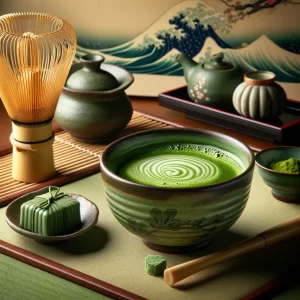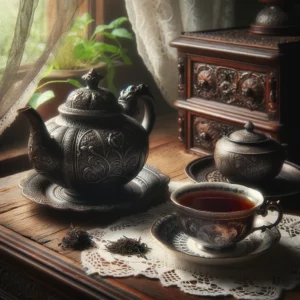Matcha tea, with its vibrant green color and rich history, has captivated the hearts of tea lovers around the world. This special kind of green tea is not just known for its unique preparation and consumption but also for its role in traditional Japanese tea ceremonies. Unlike other teas, Matcha involves consuming the whole tea leaf in powdered form, offering a unique experience both in taste and culture. This comprehensive guide delves into the world of Classic Matcha Tea, covering its origins, unique attributes, how to enjoy it, and more. Perfect for both Matcha novices and aficionados, this post will enrich your understanding and appreciation of this beloved tea.
Table of Contents
- The Rich History of Matcha
- What Makes Matcha Unique?
- Brewing the Perfect Bowl of Matcha
- Creative Ways to Enjoy Matcha
- Pairing Matcha with Foods
- Sourcing and Storing Matcha
- The Cultivation and Processing of Matcha
- Conclusion: The Timeless Appeal of Matcha
- Try Classic Matcha Tea
The Rich History of Matcha
Origins
Matcha’s story begins over a thousand years ago in ancient China, where the practice of grinding tea leaves into a fine powder and whisking them in hot water originated. However, it was in Japan where Matcha found its true home and became an integral part of the culture, especially within Zen Buddhism. The tea’s ability to induce a calm alertness made it a staple in monasteries.
Cultural Significance
In Japan, Matcha is more than just a drink; it’s a ceremonial treasure. The Japanese tea ceremony, known as Chanoyu, Sado, or simply Ocha, is a choreographed ritual of preparing and serving Matcha. This ceremony emphasizes respect, purity, tranquility, and harmony.
Evolution
From its ceremonial roots, Matcha has evolved into a popular ingredient in cafes and kitchens worldwide. Its versatility has made it a modern staple in lattes, smoothies, and even desserts, bridging the gap between traditional and contemporary tastes.
What Makes Matcha Unique?
Description of Matcha
Matcha is a fine, vivid green powder made from specially grown and processed green tea leaves. Unlike other teas, where the leaves are infused in water and then removed, Matcha involves consuming the leaf in its entirety, offering a richer nutritional profile.
The Flavor Profile
Matcha is celebrated for its complex flavor profile, which includes a perfect balance of umami (a savory taste), sweetness, and slight bitterness. This unique taste, along with its creamy texture, makes Matcha a distinct and memorable experience.
Brewing the Perfect Bowl of Matcha
Equipment Needed
To brew Matcha, you’ll need a few key items: a bamboo whisk (chasen), a tea bowl (chawan), and a measuring scoop (chashaku).
The Matcha Ritual
- Warm the bowl: Pour hot water into your tea bowl, then discard the water and dry the bowl. This warms the bowl and ensures the tea stays warm.
- Sift the Matcha: Using the scoop, place two scoops of Matcha into the bowl. Sifting prevents clumps.
- Whisk: Add hot water (just under a boil) to the bowl. Using the bamboo whisk, whisk vigorously in a zigzag motion until the tea is frothy.
Tips and Tricks
- Water Temperature: Keep the water just under boiling (around 175°F or 80°C) to avoid making the Matcha bitter.
- Quality of Matcha: Ensure you’re using ceremonial-grade Matcha for the best flavor and color.
Creative Ways to Enjoy Matcha
Beyond the Tea Bowl
Matcha’s versatility allows for creativity in the kitchen. It can be used in:
- Lattes: A Matcha latte offers a creamy, energizing start to the day.
- Smoothies: Add Matcha to your morning smoothie for a boost.
- Baking: Matcha can be incorporated into cakes, cookies, and other desserts for color and flavor.
Experimenting with Matcha
Don’t be afraid to try Matcha in various recipes. Its unique flavor complements many ingredients and can enhance both sweet and savory dishes.
Pairing Matcha with Foods
The Art of Pairing
To fully enjoy Matcha, pair it with foods that complement its rich and slightly astringent profile. Traditional Japanese sweets like mochi or wagashi are perfect, as they balance Matcha’s bitterness with their sweetness.
Recipe Ideas
- Matcha-infused pancakes: Start your day with a vibrant twist on a breakfast classic.
- Matcha smoothie bowl: Combine the nutritional benefits of fruits and Matcha in a delicious bowl.
Sourcing and Storing Matcha
Choosing Your Matcha
Look for vibrant green color and a fine texture, indicators of high-quality Matcha. Ceremonial grade is preferable for drinking, while culinary grade is suitable for cooking and baking.
Where to Buy
Select reputable brands and stores specializing in Japanese teas. Online tea shops can also offer a wide selection of high-quality Matcha.
Storage Tips
Keep Matcha in an airtight container away from light, moisture, and strong odors. Refrigeration can extend its freshness, but allow it to come to room temperature before use to prevent condensation.
The Cultivation and Processing of Matcha
From Leaf to Powder
The production of Matcha is a careful process that begins with shade-growing the tea plants. This increases chlorophyll levels, giving Matcha its bright green color and boosting its umami flavor. The leaves are then steamed, dried, and ground into a fine powder.
Conclusion: The Timeless Appeal of Matcha
Matcha tea offers a unique blend of history, culture, and flavor that has stood the test of time. From its origins in ancient tea ceremonies to its place in modern kitchens, Matcha continues to enchant with its versatility and rich taste. Whether you’re enjoying a traditional bowl of Matcha or experimenting with it in new recipes, this green tea invites you to explore its many dimensions. Embrace the world of Matcha and discover the myriad ways it can enrich your tea experience.
Try Classic Matcha Tea
“As an Amazon Associate I earn from qualifying purchases.”
[azonpress template=”grid” asin=”B078GVS6FL,B07MD4LB49″]



